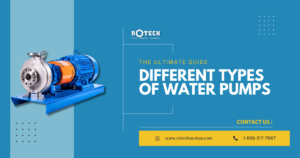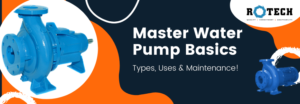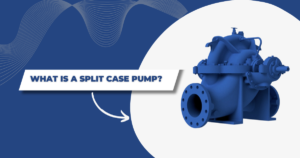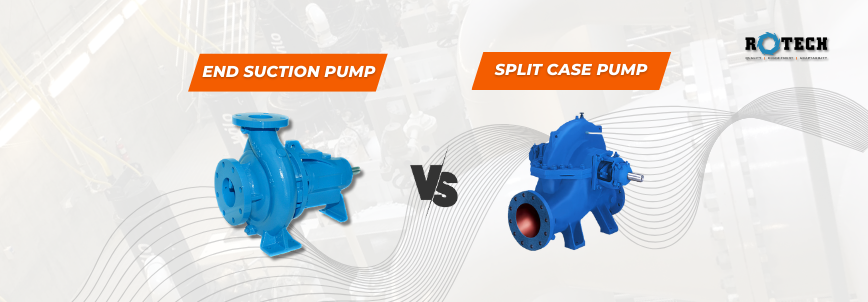Centrifugal pumps play a pivotal role in various industries by facilitating the movement of fluids. The selection of an appropriate pump type is critical to ensure optimal performance and efficiency. In this comparison, we will delve into two commonly used centrifugal pump types: End Suction Pumps and Horizontal Split-Case Pumps.
End Suction vs. Horizontal Split-Case Pumps
| Aspect | End Suction Pumps | Horizontal Split-Case Pumps |
|---|---|---|
| Design Features | Single-stage impeller, suction at one end, discharge outlet perpendicular to shaft | Two-part casing split horizontally, double-suction impeller, nozzles in opposite directions |
| Advantages | Compact size, easy installation, suitable for low to medium flow rates and head pressures | High efficiency, reliability, suitable for high flow rates and head pressures, reduced risk of cavitation |
| Limitations | Limited for high-pressure applications, potential for cavitation at high flow rates, efficiency drops at varying flow rates | Larger footprint, more complex installation and maintenance, higher initial cost |
| Industry Examples | HVAC systems, water supply, irrigation | Municipal water supply, industrial processes, power generation |
| Factors Influencing Pump Selection | Flow rate requirements, head pressure demands, space constraints, budget considerations | Flow rate requirements, head pressure demands, available installation space, budget constraints |
| Efficiency | Moderate efficiency, especially at varying flow rates | High efficiency, especially at high flow rates and head pressures |
| Energy Consumption | Moderate energy consumption, potential for fluctuations | Lower energy consumption, stable performance |
| Maintenance and Serviceability | Easier maintenance, shorter downtime | More complex maintenance, longer downtime |
| Spare Parts and Servicing Expertise | Typically readily available, simpler servicing | May require specialized parts and expertise |
| Initial Capital Cost | Lower initial cost | Higher initial cost |
| Lifecycle Cost | Potential for higher long-term operational costs | Potential for lower long-term operational costs |
| Environmental Impact | Moderate energy efficiency, potential environmental impact | High energy efficiency, reduced environmental impact |
| Rebates/Incentives Availability | Less likely to qualify for energy efficiency incentives | More likely to qualify for energy efficiency incentives |
End Suction Pumps
Definition and Basic Design Features
End suction pumps are characterized by a single-stage impeller with a suction inlet located at one end and a discharge outlet perpendicular to the pump shaft. This design makes them compact and easy to install.
Advantages
- Compact Size and Space-saving: End suction pumps are well-suited for applications with limited space, as they require less floor space compared to split-case pumps.
- Easy Installation and Maintenance: Their simple design and fewer components make them relatively straightforward to install and maintain, reducing downtime.
- Suitable for Low to Medium Flow Rates and Head Pressures: End suction pumps excel in applications where moderate flow rates and head pressures are required.
Limitations
- Limited High-Pressure Applications: They are less suitable for high-pressure applications, where split-case pumps may be more appropriate.
- Potential for Cavitation at High Flow Rates: End suction pumps may be prone to cavitation at high flow rates, which can lead to reduced performance and potential damage.
- Limited Efficiency at Varying Flow Rates: Their efficiency may drop significantly at varying flow rates, making them less suitable for systems with fluctuating demand.
Horizontal Split-Case Pumps
Definition and Basic Design Features
Horizontal split-case pumps have a unique two-part casing split along the horizontal plane, housing a double-suction impeller. This design allows for high efficiency and reliability.
Advantages
- High Efficiency and Reliability: Split-case pumps are known for their high efficiency and reliability, particularly in applications with high flow rates and head pressures.
- Suitable for High Flow Rates and Head Pressures: They excel in applications where a substantial volume of fluid needs to be moved against significant resistance.
- Reduced Risk of Cavitation: The double-suction impeller design minimizes the risk of cavitation, ensuring consistent performance.
Limitations
- Larger Footprint and Space Requirements: Split-case pumps typically have a larger footprint, which may pose challenges in installations with limited space.
- More Complex Installation and Maintenance: Their two-part casing and additional components may require more expertise and time for installation and maintenance.
- Higher Initial Cost Compared to End Suction Pumps: The initial investment for a split-case pump is often higher than that of an end suction pump, which should be factored into the decision-making process.
Application Considerations
Industry-specific Examples
- End Suction Pumps: Commonly found in HVAC systems, water supply for buildings, and irrigation systems due to their compact design and suitability for moderate flow rates.
- Horizontal Split-Case Pumps: Widely used in municipal water supply, industrial processes, and power generation where high flow rates and head pressures are crucial.
Factors Influencing Pump Selection
- Flow Rate Requirements: Determining the required flow rate is essential in choosing the appropriate pump type for a specific application.
- Head Pressure Demands: Understanding the head pressure requirements ensures the pump can handle the resistance encountered in the system.
- Space Constraints: Considering the available installation space helps determine whether an end suction or split-case pump is more suitable.
- Budget Considerations: Budget constraints can influence the initial investment and long-term cost considerations.
Performance and Efficiency
Efficiency Comparison
Comparing the efficiency of end suction and horizontal split-case pumps is essential for evaluating their overall effectiveness in different applications. Split-case pumps generally exhibit higher efficiencies, especially in high-flow, high-pressure scenarios.
Effects on Energy Consumption and Operating Costs
The choice of pump type directly impacts energy consumption and, consequently, operational costs. Split-case pumps may have higher upfront costs, but their superior efficiency can lead to long-term energy savings.
Considerations for Variable Flow Applications
In systems with fluctuating flow rates, the efficiency of the chosen pump becomes paramount. End suction pumps may experience reduced efficiency under varying conditions, while split-case pumps can provide more stable performance.
Maintenance and Serviceability
Comparison of Maintenance Requirements
End suction pumps typically have simpler designs with fewer components, resulting in easier maintenance procedures. Split-case pumps, on the other hand, may require more expertise and time for servicing.
Downtime Considerations
Downtime for repairs or overhauls is a critical factor in industries where uninterrupted operation is crucial. The ease and speed of maintenance can greatly impact overall system reliability.
Availability of Spare Parts and Servicing Expertise
The availability of spare parts and knowledgeable technicians for both pump types should be considered, as it can affect maintenance costs and downtime.
Cost Analysis
Initial Capital Cost Comparison
Comparing the initial investment required for both end suction and horizontal split-case pumps is essential in understanding the financial implications of the choice.
Lifecycle Cost Analysis
A comprehensive lifecycle cost analysis, which includes energy consumption, maintenance expenses, and potential replacement parts, provides a holistic view of the true cost of ownership.
Environmental Considerations
Energy Efficiency and Environmental Impact
Energy-efficient pumps not only reduce operational costs but also have a lower environmental impact. Understanding the environmental benefits of each pump type is crucial in sustainable applications.
Potential for Rebates or Incentives
Certain regions or industries may offer incentives or rebates for installing energy-efficient pumps, which can significantly influence the overall cost-effectiveness of the chosen pump.
Conclusion
In conclusion, the choice between End Suction Pumps and Horizontal Split-Case Pumps should be based on a thorough assessment of specific application requirements. While end suction pumps offer simplicity and suitability for low to medium-flow rates, split-case pumps excel in high-flow, high-pressure scenarios. Factors such as space constraints, budget considerations, and long-term energy efficiency should all be weighed carefully in making an informed decision.
Remember, the optimal pump selection ultimately depends on the unique demands of the system in question, and a thorough evaluation of these factors will lead to the most efficient and cost-effective solution.
Recent Posts

A Comprehensive Guide to Types of Water Pumps and Their Applications
Introduction Water pumps are indispensable

The Complete Guide to Water Pumps: Types, Uses, and Maintenance
Water is life, and the

Comprehensive Guide to Split Case Pumps
Split case pumps are a


